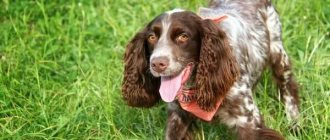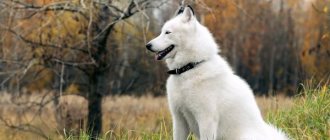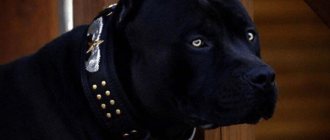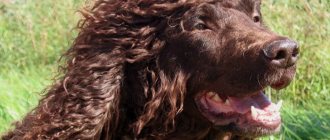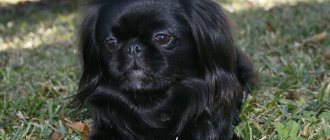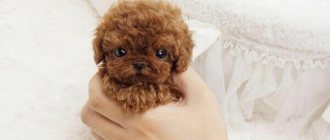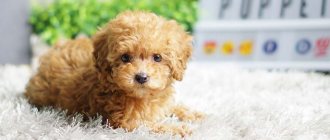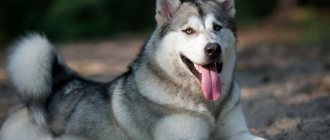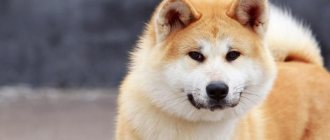Black Shiba Inus are less common than red dogs.
This color is highly valued among breeders precisely because it is less common.
And many potential owners of black Shiba Inu dream of such a pet precisely because this color is relatively rare.
What do those who are thinking about purchasing black Shibas need to know and what nuances need to be taken into account when keeping a dog of this breed in the house?
Origin story and what it looks like in the photo
The Shiba Inu is considered one of the most ancient Japanese dog breeds. Animals similar to modern Shiba appeared in Japan more than three thousand years ago.
Shibas were bred to guard Buddhist monasteries, whose inhabitants highly valued their dogs, and only later these dogs began to be used for hunting small game.
What was especially appreciated was the fact that they were not noisy: according to the monks, the absence of dog barking helped maintain silence and serene peace in the monasteries.
In most Japanese provinces in ancient times, dogs of a reddish or reddish color were bred, and only in the southwest of Honshu, in the San'in region, was preference given to dogs of black and white and black and tan color.
It was the dogs from this province that, apparently, became the main ancestors of modern black Shiba Inu.
Black and tan is considered one of the three coat colors allowed by the standard.
Expert opinion
Kozhevin Semyon Kirillovich
Expert dog handler.
Black Shiba Inus are rare: on average, their number in the population is about 20%. At the same time, not all of them meet the requirements for classic black Shibas. There should be a sufficient amount of red shades in the tan. Also required is the presence of urajiro: lightening of wool in the places specified by the standard. It is also very important that the mark on your Shiba’s chest is of the correct shape and resembles a butterfly in shape.
Training
Sibs are considered solitary dogs, and not everyone can get along with them. They are willful, moderately inquisitive and very temperamental. The Shiba Inu has another characteristic feature - ingenuity. Without a doubt, this breed of dog is smart. Teaching her is not easy, but interesting.
The relationship between a dog and its owner should be based on absolute trust. If, in the opinion of the animal, its owner is not strong enough, not only physically, but also mentally, then it will definitely not be able to rely on him for everything.
It is necessary to show the proud Sibe that he cannot occupy a leading position in the house, that is, be the alpha in the pack. He must understand that the people around him are not walking fulfillers of desires, but individuals whose position in the group is higher than his.
An animal will feel comfortable only in a house where there are no quarrels and constant conflicts. It is sensitive to people's emotions, so it gets upset if they are negative. By the way, a Shiba Inu will never follow commands if its mood is depressed.
To begin with, you must teach the dog not to shit in the house; for this, every time he starts sniffing the area in search of a “toilet,” go with him outside, saying out loud “Walk.” When the animal learns this command, it will ask to go outside every time a corresponding need arises.
The second recommendation for socializing your Shiba is to never give him food that you eat yourself. A disciplined member of the breed should not be at the family table during meals to beg.
Violation of this rule will create confusion in the relationship between household members and the dog. He will not be able to understand which rules can be broken and which ones cannot. Therefore, be sure to make sure that none of your family members treat him with anything edible.
The dog should be fed after all family members have finished eating. This will make him more obedient. A hungry animal must understand that it is not the main one in the family, so it can eat only after everyone who lives with it has completed the meal.
As for performing standard dog commands, for example, “give me a paw,” the Shiba Inu learns them very quickly. But knowledge is one thing, execution is another. If you offend your pet by yelling or hitting him, then do not expect him to obey your command.
If an animal is offended, it may begin to chew wires, furniture and objects lying on the floor. When you notice that your Shiba is doing something inappropriate, say the word “No” loudly. He must associate this command with a ban. These are smart dogs who will not break the rules they learned in childhood.
Due to the proud, wayward nature, there are difficulties in raising and training the Shiba Inu.
Never cause physical harm to your four-legged friend - he will never forgive you for this. You can destroy a trusting relationship with a proud Shiba Inu by hitting him once. Remember, the animal should not be afraid of you. It is important that it is obedient and loves you.
Shiba Inu training can take place not only in the house, but also in an open space. The ideal option is to train the dog at the stadium. You can train him to bring you a stick by throwing it far ahead.
Also, don’t forget about dog endurance training. Run with your Shiba around the stadium, invite him to jump over obstacles, etc. Physical activity will help him strengthen his muscles and become more resilient.
Character traits
Black Shiba Inus are a bit like cats in their character: they are also independent, attentive, careful and at the same time self-confident..
They love their owners, but in their own way: these dogs will definitely not obey their commands contrary to their interests or desires. Many owners consider this a manifestation of stubbornness or harmful character, but this is a completely different matter.
It’s just that the Shiba Inu, like most other Asian breeds, has its own opinion on everything and if it does not coincide with the owner’s, the dog will do as it sees fit.
However, if you raise and train your pet correctly, acting not with severity, but with kindness and affection, then you can achieve obedience from the Shiba Inu in almost any situation.
In Japan, the Shiba Inu is most valued for three qualities that these dogs have: good disposition, courageous audacity and simplicity.
Price
Shiba Inu is a rare breed in Russia, and therefore expensive. If you like solitary dogs that have excellent hunting potential and are easy to care for, then this breed is perfect for you.
Shiba Inu puppies are often born dark, so it is difficult to predict what shade their fur will be. But, if you want to purchase a classic red representative of the breed, then you need to go shopping 2-3 months after his birth. By this time, the color of the animal will definitely be clear.
There are 2 ways to purchase a Shiba: from a private breeder, that is, from your own hands and in a nursery. The price of a Shiba Inu without a pedigree and other documents is from $250. If you plan to make money from your pet, then you need to make sure that it has a pedigree.
They give it in kennels, like the rest of the dog’s documents, including his passport. The price of such a dog is higher, from $2,500. If the puppy’s parents are champions and winners of exhibitions, then its cost can reach up to $3,000.
Black color options
Pure black
Most often, dogs of a black sesame color can look pure black, the fur of which has a very strong darkening, which is why the dog, especially in certain lighting, can look almost black.
True black Shiba Inus are even rarer and appear to be descendants of lines where there were once instances of interbreeding..
Black and Tan
This color resembles the color of a Rottweiler: with it, in places determined by the standard, golden-red markings are located on a basic black background.
The difference between a black and tan Rottweiler and a Shiba Inu of the same color is that the latter must have an urajiro.
Tricolor
This color is not recognized by the FCI standard . With this coloring, similar to black and tan, the dog also has white markings, making up no more than 50% of the total color.
Black and white
It can be observed with a very dark tan, in which the reddish markings are almost invisible. Moreover, these Shiba Inus have white markings.
All black colors except black and tan are considered plembraceous..
Advantages and disadvantages
pros:
- Well-developed guard instincts make Shiba Inu good guards.
- Rare color and exotic appearance.
- Well suited for keeping in an apartment.
- They can live in an enclosure or in the yard almost all year round.
- They don't smell.
- They are distinguished by intelligence, intelligence and at the same time very intelligent.
Minuses:
- When training, you have to look for an individual approach to training your pet.
- These dogs need quite a lot of exercise.
- Shiba Inus have a natural hunting instinct, which is why they can pose a danger to small animals and birds.
- Due to their inherent self-centeredness, Shiba Inus do not get along very well with other dogs.
Many representatives of this breed are quite picky eaters and need individual diets.
Dimensions, weight and other distinctive features
The table below shows the sizes of the Shiba Inu and a description of the standard of this breed.
| Options | Description |
| Dimensions | Males - 38 - 41 cm Bitches - 35 - 38 cm |
| Weight | Males - 10-13 kg Bitches - 7-9 kg |
| Body Format | In males it is 100:110, in females the body is slightly more stretched. |
| Head | Must be proportional to the body. The skull is quite wide, the transition to the muzzle is well defined. |
| Muzzle | Quite wide at the base and tapering towards the nose, the shape resembles a fox, but somewhat more voluminous. Its length is approximately 40% of the total length of the head. |
| Cheekbones | Moderately expressed. |
| Eyes | Triangular, medium-sized, slightly slanting. Eye color should be dark brown. |
| Ears | Triangular in shape, relatively small, quite dense. |
| Stomach | Moderately tucked in, not pulled in, but not saggy either. |
| Tail | Set high and quite thick at the base. Usually, it is either rolled into a ring or crescent-shaped |
| Wool | The so-called “wild” type, very dense and dense. The Shiba Inu's coat consists of a straight and harsh coat and a fairly soft and dense undercoat. The hair on the tail is longer than on the body and head. |
| Color | The only acceptable black color standard for Shiba Inu is considered to be black and tan coat color. |
IMPORTANT! With a black and tan color, a Shiba Inu must have urajiro - lightening to an almost white shade of hair on the back of the paws and tail, as well as on the neck, chest, cheekbones and muzzle.
brief information
Useful brief information about the main parameters of a dog of the Shiba Inu breed, or Shiba Inu in other words, the ICF classification and information about its closest relatives (breeds) are presented in the table
| ICF classification | 5. Spitz and primitive breeds |
| 5. Asian Spitz and related breeds | |
| Number - 257 | |
| Country of origin | Japan, origins 3rd century BC. era |
| Weight | 7-14 kg |
| Height | 35 – 42cm (males 41cm, females 37cm) |
| Wool | Dense, thick, short |
| Color | White, red, black, dark gray |
| Immediate family | Shar Pei, Chow Chow, Akita Inu |
| Life cycle | 13 – 18 years old |
Life expectancy and what diseases are they susceptible to?
On average, dogs of this breed live from 12 to 15 years. Shiba Inus, as a rule, rarely get sick.
However, they have a breed predisposition to certain diseases, such as:
- Allergy
- Retinal atrophy
- von Willebrand disease
- Patella luxation
- Hypothyroidism
- Turn of the century
- Cataract
- Pyoderma
Shibs are very sensitive to infectious diseases, and therefore it is necessary to vaccinate on time.
History of the Shiba Inu breed
Dogs similar in appearance to the Shiba Inu lived in Japan more than three thousand years ago. This is evidenced by ceramic figurines found by archaeologists, as well as genetic studies. After the massive import of hunting dogs to Japan from England, the appearance of the Shiba Inu began to change, and there were fewer and fewer purebred individuals. 1936 is the year the Shiba Inu was recognized as a separate breed. A group of enthusiasts made every effort to preserve the exterior. And now this breed is one of the most beloved in Japan.
Basic rules of care
During shedding, black Shiba Inus need to be brushed daily; at other times, you can get by with less frequent brushing, for example, doing this procedure 2-3 times a week.
The Shiba Inu's coat has the property of self-cleaning, and since these dogs are very clean and rarely get dirty, they need to be washed no more than 2-3 times a year.
Eyes and ears are cleaned 3 times a month, but examined daily. The Shiba Inu's nails should be trimmed as needed.
Your pet's teeth can be cleaned using a special brush and toothpaste . But it's better to just let him chew on toys or treats to clean his teeth.
How to choose?
You should only buy a black Shiba Inu from a kennel or from a breeder recommended by the kennel club..
When choosing a Shiba Inu puppy, you need to pay attention to the brightness of its color and how proportional it looks.
IMPORTANT!
It is necessary to give preference to puppies with a strongly built, but not too squat body, a head commensurate with the body, a slightly shortened, pointed, but not narrow muzzle, with a tail of the correct shape and rather thick paws.
The puppy must be friendly towards people, and active, in addition, he must look well-groomed and be completely healthy.
Regarding color, I would like to note that it is best to take black Shiba Inu puppies with the brightest coat color and reddish rather than whitish tan.
Nutrition
Food is what keeps a living thing alive. A puppy needs a regular supply of nutrients, including vitamins, to its body. He should eat at least 4 times a day, preferably in small portions.
The Shiba Inu is considered a strong and resilient dog, but to keep it healthy, it is important to plan your menu properly. The puppy's main food is raw meat. Yes, the smell of this product can really provoke predatory aggression in your four-legged friend. But, this only happens during meals. Therefore, when an animal eats meat, do not talk to it until the end of the meal.
Without this product, he will not gain the necessary muscle mass. It is advisable to give your Shibe rabbit, beef or chicken, but not pork. Also, do not deny him the pleasure of eating healthy vegetables, such as beets or tomatoes. It is recommended to steam them. You can also cook vegetable soups for your dog. Sweets, baked goods and processed foods for dogs are prohibited.
